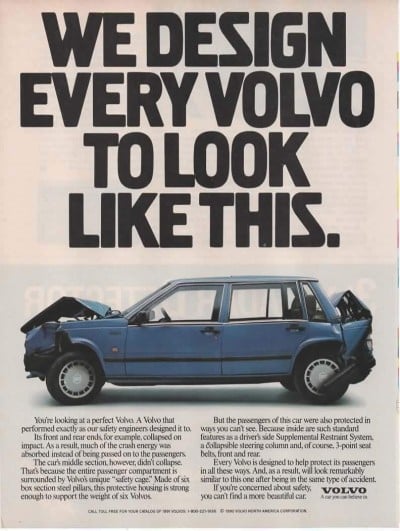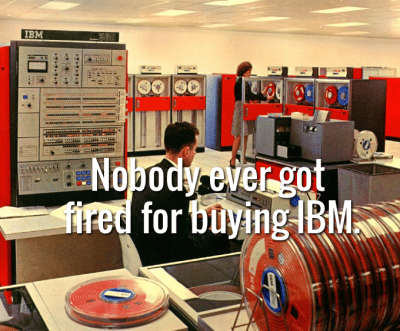
Because branding is association design, brand-builders must give serious thought to the associations they wish to attach to their brand.
These desired associations are often called “brand attributes.”
In simple terms: what do you want your brand to be known for?
 For example: Volvo is popularly associated with safety and durability.
For example: Volvo is popularly associated with safety and durability.
And those associations did not occur by accident.
Nor did they occur from the ground up as a form of user sentiment spread through word-of-mouth, in viral fashion.
Sure, there was a solid core of truth backing up those claims and associations, but they could have also been made about, say, Mercedes vehicles as well.
The point is those associations were intentionally and explicitly created by the ad teams at Ali & Gargano and then Scali, McCabe, Sloves, who put those associations into your head via broadcast diffusion.
And then, through some combination of The Sleeper Effect and Cultural Imprinting, what Volvo said about Volvo in their ads transmuted into popularly held sentiment.
That’s (mostly) how branding works.
And yet, while every brand might have differing brand attributes, there’s one attribute that’s essential to all brands.
It is THE key attribute, without which, nothing else will matter.
But to understand why this attribute is key — and how to “own” and harness its power — you have to understand why companies brand themselves in the first place:
- To influence customers to buy from you rather than someone else, and
- To influence customers to willingly pay MORE for you than someone else
In other words, we brand to increase market share/sales while increasing profit margin.
And in both cases THE key attribute you need is TRUST.
If the customer Trusts you, but doubts his other options, he’ll not only prefer you, but will gladly pay more for a “sure thing.”
Trust, IBM, Ronseal, and H&K
This is why IBM could famously charge more for less capable systems than upstart, hi-tech competitors by employing FUD — Fear, Uncertainty, and Doubt.
 “Sure, that other company has better claimed specs, but are you sure they’ll deliver on them in reality, after you’ve given them the bid?
“Sure, that other company has better claimed specs, but are you sure they’ll deliver on them in reality, after you’ve given them the bid?
And what happens if they don’t? What happens if there’s a problem a few years down the road and that other company has gone out of business?
And who do you think will get the blame for that?”
As the saying goes, “Nobody ever got fired for going with IBM.”
Then there’s the two slogans that I’ve claimed cover 90% of branding for local companies:
- Ronseal’s “Does exactly what it says on the tin,” and
- H&K’s “In a World of Compromise, Some Don’t”
Notice that those phrases are aimed at nothing but creating Trust in the brand. Because trust is the one attribute that matters most.
Trust alone will make your brand a winner.
And without trust, no combination of other associations and attributes will matter.
Is Your Ad Campaign Creating Trust?
It seems like a simple question. Almost too simple, really.
Are your ads effectively building trust with your target audience?
But it’s not uncommon for companies and advertising professionals to get so caught up in figuring out all their other brand attributes to miss out on trust.
Or they get so involved in entertaining listeners or viewers that they forget to build trust while they’re at it.
And this really is the beauty of a good bonding campaign, kicked off with a strong origin story — nothing builds trust faster.
So if you’re looking to take your advertising to the next level, why not hire someone skilled at creating the kind trust in your brand required to make that leap?
- Getting a Foot in the Door — Of Perception - November 27, 2025
- What Digital Superstars Know About Offline Advertising - November 17, 2025
- Unmistakable: A Tale of Two Boots and Branding Done Right - November 8, 2025
